Review copy provided by EA. Reviewed on PC.
It’s hard to overstate the burden of expectations that Anthem has been carrying. After the disappointing launch of Mass Effect: Andromeda and the shuttering of their Montreal division, the hype behind the new open-world shooter from EA’s BioWare has been immense. BioWare has form in creating fascinating science-fiction worlds. They are the studio behind Star Wars: Knights of the Old Republic and Mass Effect, after all. But Anthem is very different. BioWare has never made anything like it.

Rather than a massive single-player RPG focused on storytelling, Anthem is an always-online shared world action RPG that leans heavily on the service model EA has been pursuing to great effect with their other titles like their recent surprise hit battle royale Apex Legends. There are legitimate reasons why fans of BioWare would be worried about such a sudden and drastic shift in direction from the legendary studio. Although it’s sometimes a bumpy ride, those concerned about Anthem’s quality can take a sigh of relief. For the most part, it delivers on its promise of exciting movement, enjoyable shooting mechanics, and quality storytelling.
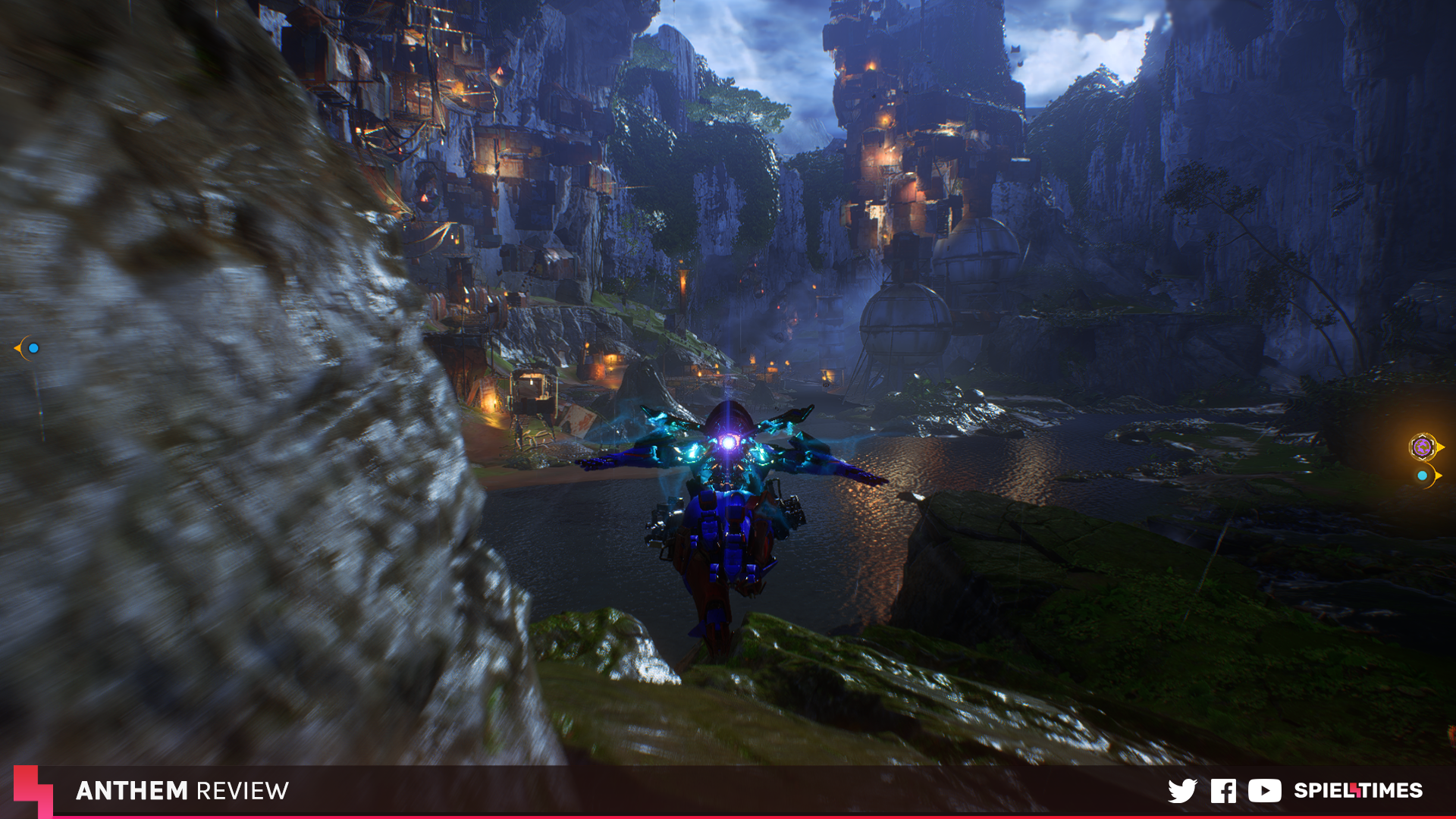
Anthem’s opening sequence is exhilarating. You play as a “Freelancer,” a group of independent soldiers tasked with protecting what remains of humanity from threats both manmade and natural by wielding mechanical combat suits known as javelins. Your party soon sets out on a suicide mission to the Heart of Rage, a supernatural storm raging in the heart of the city Freemark.
Anthem’s plot is a bit of a mixed bag, although production values are high, with stellar voice work from the likes of 30 Rock’s Jack McBrayer and Ray Chase, the voice of Noctis from Final Fantasy XV.
This “cataclysm” unleashes all manner of beasts into the human homeland of Antium. Naturally, it’s down to the main characters, the Freelancers and their psychic guides known as Cyphers, to stop this strange supernatural rift from overwhelming the population. The opening sequence wastes little time in shoving players right into the heart of the action, battling large ogres called Titans and human-sized venomous insects, the Skorpions.
It’s a bit overwhelming at first. Characters talk to the player as if they already know what “shaper relics” and “Arcanists” are. Don’t be surprised if you get confused trying to make heads or tails of Anthem’s vernacular at first, and the game doesn’t do a great job explaining all these terms until much later. In general, Anthem’s plot is a bit of a mixed bag, although production values are high, with stellar voice work from the likes of 30 Rock’s Jack McBrayer and Ray Chase, the voice of Noctis from Final Fantasy XV.
The game’s controls are fluid and responsive. Soaring through the tree canopy of Antium and out through jagged cliffs, dense foliage, and expansive waterfalls are incredibly satisfying. I haven’t played a game that has nailed the feeling of freedom in flying as well as Anthem does. Slick barrel rolls glide easily into fearsome aerial twirls that finish in an explosive stomp, taking down nearby enemies. The transition from flight to combat is handled very well. It doesn’t take long before moving from gliding to hovering in place and firing or coming to ground for bursts of melee feels like second nature.
The game’s variety of skills are numerous, balanced, and, for the most part, well-executed. Whether poisoning enemies with a cloud of toxic gas, targeting foes with homing missiles or high explosive bombs or helping your allies with support skills that clear your team of debuffs, nearly every build is viable here. The game’s classes comprise the balanced Ranger, the tanky, mammoth, slow and destructive Colossus, the mage-like Storm, and the high-speed movement and melee focused Interceptor.
I spent most of my playthrough as the Interceptor, and I warmed to its unique playstyle. You’ll find yourself jetting across the arena, lobbing poison grenades at hostile troops before slamming them into the ground and unleashing your acrobatic melee moves. The Interceptor discourages gunplay, as its melee options are fast and aggressive enough to take down enemies faster than with the game’s range of weapons, which include the usual assortment of assault rifles, snipers, shotguns, and machine pistols.
Anthem’s gunplay is competent but never brilliant, and raining fire on your opponents often lacks a feeling of impact or recoil. I found the melee much more exciting and dynamic, where flashy, stylish animations encourage the player to explore the full freedom of movement the javelins provide. Unfortunately, the game discourages experimentation with different classes of javelin rather than supporting players who want to find their own rhythm. Once you select a javelin early on, you are locked to your choice for much of the campaign, only unlocking the full arsenal of javelins to experiment with well into Anthem’s postgame. Luckily, javelins have huge potential for customization, with varieties of paint colors, body parts, and varnishes available– I decked mine out with striking neon blues and reds.
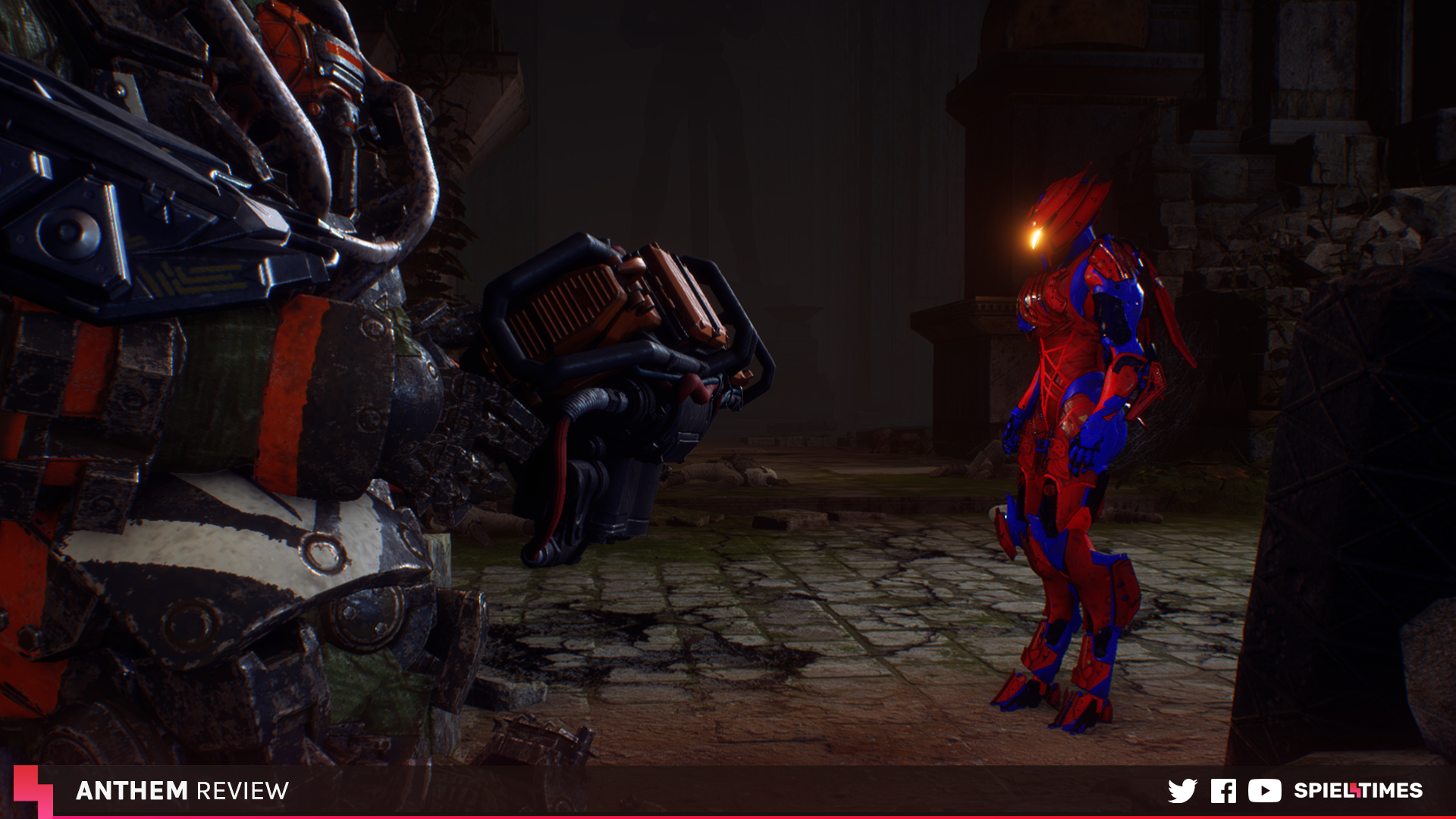
One of Anthem’s largest flaws is the repetitive mission structure and level design. Missions often account to little more than flying to a similar outdoor enemy encampment or indoor cave and whittling away at enemy’s health bars while a meter fills around an objective marker. While the game’s environments are often striking in their beauty, they don’t provide enough variety to make the samey encounters found within them stand out. This isn’t as much of an issue if you enjoy Anthem’s core gameplay loop, and I certainly do. But running the same dungeons (known as Strongholds) could quickly become tiring if you’re less enamored with Anthem’s core mechanics than I was.
I can’t avoid mentioning the many technical issues and bugs I experienced during my playthrough of Anthem’s campaign and side content. Essential story missions become confusing when you’re matchmade into a party already halfway through a mission. It certainly adds to the confusion when you find your teammates firing at enemies you can’t see, who spawn in thirty seconds later but sometimes de-spawn right afterwards, suddenly appearing and disappearing in front of you with no warning.
Sometimes the audio completely cuts out in the middle of the missions, forcing me to try and juggle reading subtitles and taking down enemies. EA and BioWare pushed out a patch soon afterward that fixed some of these bugs, but introduced others, like an issue where geometry in the hub area Fort Tarsis wouldn’t load in, leaving characters I needed to talk to floating mid-air and forcing me to restart the game client or an issue where enemy health-bars would suddenly restore themselves close to death. None of these issues ruined my experience with Anthem, but they add unnecessary frustration. It’s hard to shake the feeling that the game released too soon, and could have greatly benefited from more time to polish these details.
Another sticking point revolves around the game’s progression. While the pacing of the story builds effectively for the first half of the game, the second half is marred with multiple artificial barriers to story progression. That would be fine if these barriers properly encouraged exploration, but one particularly egregious example involved a dozen or so checklists of menial tasks, all of which you must complete before being allowed to progress through the story. I hope you enjoy hunting down fifteen random chests, killing fifty enemies with your ultimate ability, collecting from twenty-five harvest points, and so on. At one point, I found myself joining random missions and begging my fellow players over voice chat to kill themselves so I could revive them enough times to reach the quota required to progress the story. This section takes a few hours of playtime and wrecks the momentum the game’s story had developed up to that point.
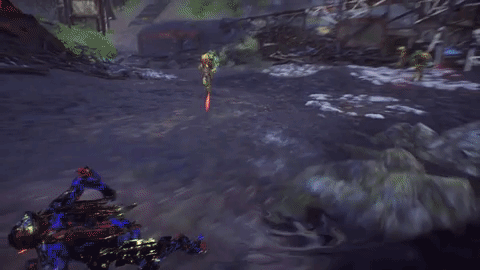
A more positive note is the game’s sound design, which is, mostly effective and well-executed. Guns thump with a metallic bang, jets on javelins whirr with a powerful roar, and Skorpions split open with a satisfying crack. The game’s stereo panning for headphones provides a great sense of direction, and the music ranges from growling ambient synths to sweeping waves of orchestral strings and choir. One missing piece is music for the hub area Fort Tarsis, which feels strangely dead with its general lack of sound effects. You will sometimes see characters speaking to each other in this area, but if you move closer to them you’ll hear complete silence while they continue to lip-sync. It’s a strange oversight, and more ambient dialogue in Fort Tarsis could have helped fill in more of the game’s lore skipped over in story scenes.
I wish more of the game’s story was told in those many cutscenes, which are mostly effective but often fall into cliché. You are the ragtag rebels, who are perfectly heroic and determined, fighting back against the faceless evil baddies, the Dominion, whose leader, The Monitor, is pure evil and must be stopped from unleashing their vague evil plan. It’s nothing we haven’t seen before, and you’ll see the game’s contrived plot twist coming a mile away.
These cutscenes fail to fully explore the world of Antium or the mystery of the ancient creators, the Shapers, who created the game’s world and the technology within it long ago. Much of the lore is told in the form of text logs and scrolls found lying around in the game’s large open map and the first-person hub area, Fort Tarsis. It’s not an ideal way to experience the lore of Anthem.
With such impressive cutscenes and an abundance of character dialogue over the radio during missions, players might be tempted to skip over the diegetic storytelling found in these many pieces of text. But that would be a mistake. Many of these short paragraphs are crucial to understanding more about the mysteries of Anthem’s world.
There will undoubtedly be controversy over the relationship Anthem has with that BioWare of years gone by, whose Baldur’s Gate, Neverwinter Nights, and Mass Effect series helped define the possibilities for depth in storytelling, characterization, and worldbuilding in role-playing games. Anthem’s world certainly lacks the depth of those titles. It is also a shorter game than any entry in those series, so expect a playthrough of the campaign to last around fifteen hours.
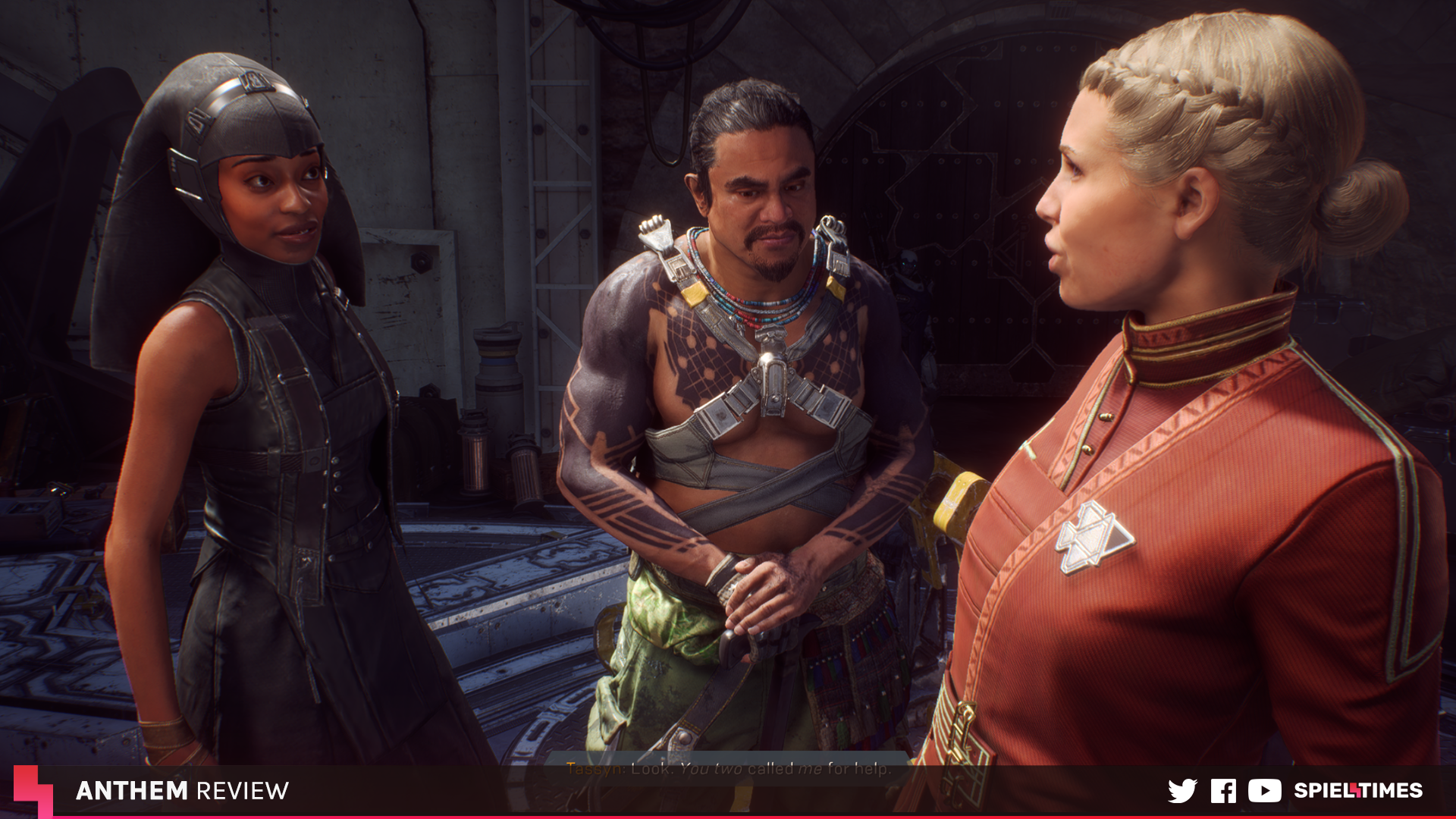
Where the story of Anthem succeeds is in the strength of its characters, who are often charming and well-written. Haluk is a gruff, grizzled Freelancer past his prime by some years, portly and charming as he sulks around the team’s large robotic transport carrier with his cane. Equally, their British-accented Cypher named Faye speaks with authority and compassion when she commands and advises the squad from her battle station, a series of machines and computers hooked up to a chair straight out of The Matrix that is said to attune her psychic abilities.
Less successful is her comic-relief replacement for much of the game, Owen, whose mission commentary grates at times. The same could be said for Sentinel Dax, whose ditzy, relaxed nature is played against her royal heritage to mixed effect. But it’s best not to linger on the moments when the game’s characterization fails since, for so much of Anthem’s fifteen-hour campaign, the characters and their performances shine. This is where we see the most of the old BioWare come through, and where the studio demonstrates that their capability to pair protagonists with a troupe of interesting and endearing side characters remains.
Although it doesn’t quite match the next-generation promise of its E3 press conference reveal, there’s no doubt that Anthem is a visually stunning game that pushes the current generation of consoles to their technical limitations. The game’s dynamic lighting is awe-inspiring at times, and detailed geometry, character models, and javelins are highly polished and impressive. Textures, too, are rich and detailed for the most part– with some minor exceptions. Facial animations and characters, in general, are a huge step up from the strange flesh puppets of Mass Effect: Andromeda. While it doesn’t quite reach the splendor of its most impressive competitors like Red Dead Redemption 2 and God of War, its graphical fidelity deserves to be mentioned alongside those giants of the industry.
There are valid concerns about Anthem’s future content roadmap that I’m sure BioWare will be addressing in updates and expansions to come. The game and story as it exists feel very much like the foundations of a world ready to be built and expanded upon. The current endgame content is a bit sparse, and I could imagine that grind wearing thin quickly and negatively impacting the desire for players to return to Anthem after finishing the campaign if it wasn’t for the satisfying loot provided as the game’s difficulty ramps up in these postgame sections.
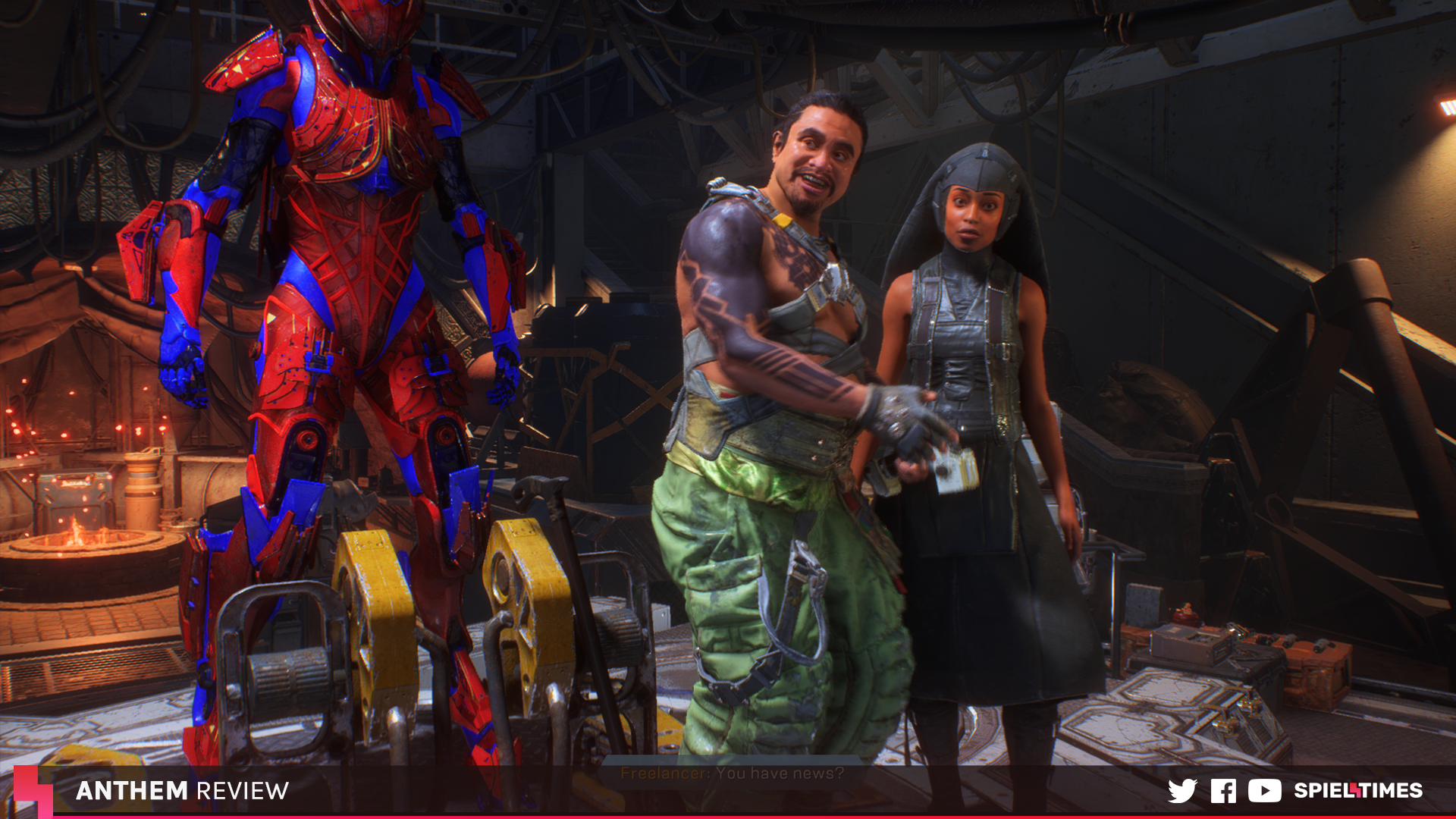
The game’s value at full-price is subjective, but that question becomes more nebulous when you consider programs like EA Access and Origin Access which let players try the game for a lower subscription cost. As with many of these service-based titles, some will undoubtedly wait for a discount or for further content updates and expansions before diving into Anthem, and that’s probably a smart move.
Whether Anthem surpasses or fails to meet expectations depends largely on the audience who evaluates it. Devoted fans of BioWare may be disappointed that Anthem is not the next Mass Effect. It lacks the depth in worldbuilding and storytelling that the studio has shown in the past, and that may rankle with some long-time devotees of the studio known for their deep single-player RPGs. But those who were attracted to Anthem based on the promise of an exciting shared world looter shooter will find a lot to love in Anthem’s satisfying flight and combat.
The future of this legendary developer remains a question for another day, but its followers shouldn’t be so quick to write off this new franchise. This Anthem may not be a perfect song, but it has a lot of promise.
